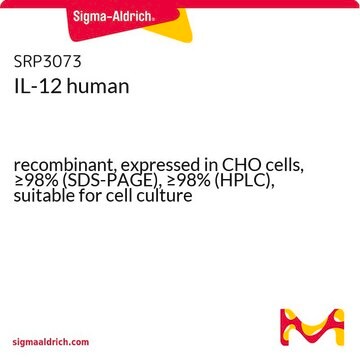推薦產品
生物源
human
品質等級
重組細胞
expressed in Sf21 cells
化驗
≥97% (SDS-PAGE)
形狀
lyophilized powder
分子量
protein 70 kDa
技術
cell culture | mammalian: suitable
雜質
endotoxin, tested
適合性
suitable for molecular biology
UniProt登錄號
儲存溫度
−20°C
基因資訊
human ... TGFB1(7040)
一般說明
Research Area: Cell Signaling
TGF-β is released from degranulating platelets and secreted from nearly all cells in a biologically inactive complex which is unable to bind to cellular receptors and is not recognized by antibodies to TGF-β. The peptide can be activated by acidification, alkalinization, or action of chaotropic agents in vitro. The complex consists of TGF-β associated non-covalently with a protein designated as the latency associated peptide (LAP). TGF-β and LAP represent components of a pro-peptide that is cleaved in a post-golgi compartment prior to secretion. The recombinant human LAP is produced from a DNA sequence corresponding to the 278 amino acid residues of pre-pro-TGF-β1 terminating prior to the mature TGF-β1. LAP contains a Cys33 to Ser33 substitution. LAP contains 249 amino acids, generated after cleavage of a 29 amino acid residue signal peptide. LAP is a glycoslyated, disulfide linked homodimer.
TGF-β is released from degranulating platelets and secreted from nearly all cells in a biologically inactive complex which is unable to bind to cellular receptors and is not recognized by antibodies to TGF-β. The peptide can be activated by acidification, alkalinization, or action of chaotropic agents in vitro. The complex consists of TGF-β associated non-covalently with a protein designated as the latency associated peptide (LAP). TGF-β and LAP represent components of a pro-peptide that is cleaved in a post-golgi compartment prior to secretion. The recombinant human LAP is produced from a DNA sequence corresponding to the 278 amino acid residues of pre-pro-TGF-β1 terminating prior to the mature TGF-β1. LAP contains a Cys33 to Ser33 substitution. LAP contains 249 amino acids, generated after cleavage of a 29 amino acid residue signal peptide. LAP is a glycoslyated, disulfide linked homodimer.
應用
Latency Associated Peptide (LAP) may be used to inhibit transforming growth factor-β 1 activity in various biological systems.
Transforming Growth Factor-β1 Latency Associated Peptide human has been used to coat the cell culture inserts for cell migration assays to determine the functional effects of impeding αvβ6 endocytosis in vitro. It has also been used to coat non-tissue culture-treated 96-well plates for adhesion assays.
生化/生理作用
Latency Associated Peptide (LAP) binds transforming growth factor-beta 1 (TGF-β1) to form a latent complex. The activity of TGF-β1 is primarily regulated through the activation of the latent molecule. LAP has the ability to stimulate epithelial cell migration, representing a new function for LAP in controlling monocyte trafficking and immune modulation. Following post-translational modification, TGF-β1 binds non-covalently to the LAP to establish latency. Due to its crucial function in modulating TGF-β1 activity, LAP plays a fundamental role in governing a range of TGF-β1 effects. LAP is expressed on immature dendritic cells and contributes to T cell differentiation. LAP exhibits both chemotactic and anti-inflammatory activity independently of active TGF-β1.
TGF-β1 is produced by many cell types, but is reported to be most concentrated in mammalian platelets, where it is present at approximately four times the level of TGF-β2.
外觀
Lyophilized from 0.2 μm filtered phosphate buffered saline containing 1.25 mg bovine serum albumin.
分析報告
The biological activity is measured by its ability to inhibit TGF-β1 activity on mouse HT-2 cells.
免責聲明
Unless otherwise stated in our catalog or other company documentation accompanying the product(s), our products are intended for research use only and are not to be used for any other purpose, which includes but is not limited to, unauthorized commercial uses, in vitro diagnostic uses, ex vivo or in vivo therapeutic uses or any type of consumption or application to humans or animals.
儲存類別代碼
11 - Combustible Solids
水污染物質分類(WGK)
WGK 3
閃點(°F)
Not applicable
閃點(°C)
Not applicable
個人防護裝備
Eyeshields, Gloves, type N95 (US)
分析證明 (COA)
輸入產品批次/批號來搜索 分析證明 (COA)。在產品’s標籤上找到批次和批號,寫有 ‘Lot’或‘Batch’.。
Latency associated peptide has in vitro and in vivo immune effects independent of TGF-beta1
Ali NA, et al,
PLoS ONE, 3(4), e1914-e1914 (2008)
Loss of MMP-8 in ductal carcinoma in situ (DCIS)-associated myoepithelial cells contributes to tumour promotion through altered adhesive and proteolytic function
Sarper M, et al.
Breast Cancer Research, 1-19 (2017)
Muge Sarper et al.
Breast cancer research : BCR, 19(1), 33-33 (2017-03-24)
Normal myoepithelial cells (MECs) play an important tumour-suppressor role in the breast but display an altered phenotype in ductal carcinoma in situ (DCIS), gaining tumour-promoter functions. Matrix metalloproteinase-8 (MMP-8) is expressed by normal MECs but is lost in DCIS. This
我們的科學家團隊在所有研究領域都有豐富的經驗,包括生命科學、材料科學、化學合成、色譜、分析等.
聯絡技術服務




